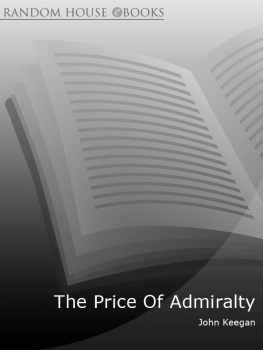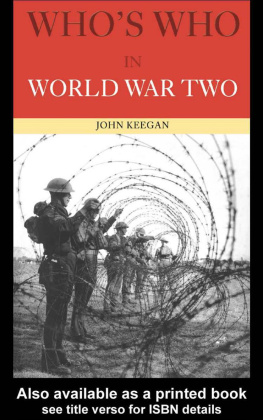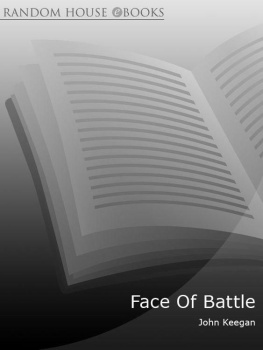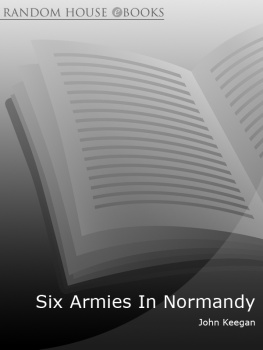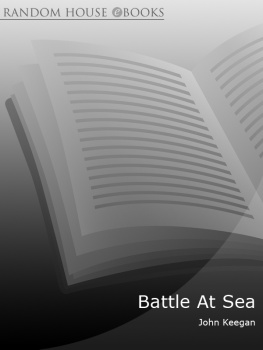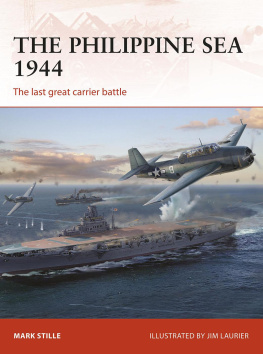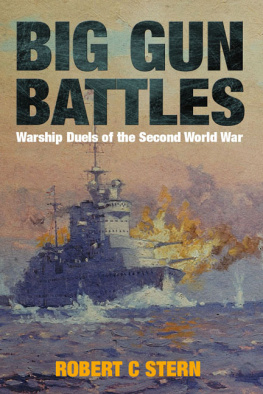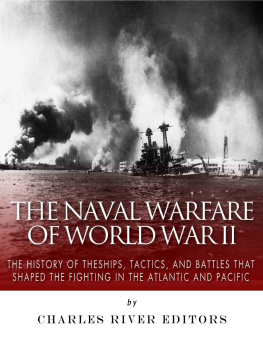JOHN KEEGAN
THE PRICE OF
ADMIRALTY
War at Sea
from Man of War to Submarine

This eBook is copyright material and must not be copied, reproduced, transferred, distributed, leased, licensed or publicly performed or used in any way except as specifically permitted in writing by the publishers, as allowed under the terms and conditions under which it was purchased or as strictly permitted by applicable copyright law. Any unauthorised distribution or use of this text may be a direct infringement of the authors and publishers rights and those responsible may be liable in law accordingly.
Version 1.0
Epub ISBN 9781446494509
www.randomhouse.co.uk
John Keegan 1988
All rights reserved
This edition first published in Great Britain
by Hutchinson, an imprint of
Century Hutchinson Ltd, Brookmount House,
6265 Chandos Place, London WC2N 4NW
Century Hutchinson Australia (Pty) Ltd
8991 Albion Street, Surry Hills, NSW 2010
Century Hutchinson, New Zealand Limited
PO Box 40086, Glenfield, Auckland 10
New Zealand
Century Hutchinson South Africa (Pty) Ltd
PO Box 337, Bergvlei 2012, South Africa
ISBN 0 09 173771 0
CONTENTS
In memory
of my grandfather
John Bridgman
(18821954)
of Toomdeely, County Limerick
and for my son
Thomas John Bridgman Keegan
and my grandson
Benjamin Bridgman Newmark
Also by John Keegan
The Face of Battle
The Nature of War (with Joseph Darracott)
World Armies
Whos Who in Military History (with Andrew Wheatcroft)
Six Armies in Normandy
Soldiers (with Richard Holmes)
The Mask of Command
List of Illustrations
, flagship of the Spanish Admiral Cisneros at Trafalgar
, by Denis Dighton
by Clarkson Stanfield
, as painted by Constable
by William Turner
, Jellicoes flagship at Jutland
, of the 5th Battle Squadron
after Jutland
suffering a hit by Lutzow
searching for survivors
steaming to engage the German battle line
aboard HMS Iron Duke
, commander of the Battlecruiser Fleet at Jutland
, commander of the First Scouting Group of Gann battlecruisers at Jutland
, commander of the German High Seas Fleet, Admiral Prince Heinrich and the German Crown Prince
, flagship of Admiral Fletcher
escaping from the Battle of Midway
manoeuvring at high speed
, commander of US carrier forces
, commander of the Japanese carrier fleet
, commander of the Japanese Combined Fleet
, a Type VII U-boat, on exercise in the Baltic
, commander, Western Approaches
, commander of the German U-boat fleet congratulating Lieutenant Otto Kretschmer
Maps
ACKNOWLEDGEMENTS
My thanks are due first to those who taught me the little I know about ships, seamanship and sailing: John Watson, of Trinity College, Oxford, who taught me to sail in a Fleetwind dinghy at Port Meadow in our freshman term in 1953; the officers of the Royal Military Academy Sandhurst Sailing Club, and particularly Lieutenant-Colonel John Carver, with whom I cruised in the Sandhurst yachts Wishstream and Wishstream II in the Solent and Channel in 196070; the naval historian, the late A. B. Rodger, my Balliol tutor; and my grandfather, John Bridgman, whose lifelong interest in the sea aroused my own. It was he who introduced me to the classics of naval and nautical literature in childhood, made me ship models, told me sea stories and launched me in imagination on the waters. He was the most delightful of grandfathers.
My thanks are also due to the staffs of several specialist libraries: Mr Andrew Orgill and his staff at the Central Library, Royal Military Academy Sandhurst; Mr Michael Sims and his staff at the Staff College Library; Mr John Andrews and Miss Mavis Simpson at the Ministry of Defence Library; and the staffs of the National Maritime Museum Library and the London Library.
I should particularly like to thank friends and colleagues at the Royal Military Academy Sandhurst and the Daily Telegraph: Mr James Allan, Mr Conrad Black, Dr Anthony Clayton, Lord Deedes, Mr Jeremy Deedes, Mr Trevor Grove, Mr Nigel Horne, Mr Andrew Hutchinson, Miss Claire Jordan, Mr Andrew Knight, Mr Michael Orr, Mr Nigel Wade and Mr Ned Willmott; Ned Willmotts capacity to answer the most abstruse enquiry about twentieth-century naval history without recourse to printed sources continues to astonish me. I owe warmest thanks of all to Mr Max Hastings, who allowed me the time to write this book.
The manuscript was deciphered and typed by Miss Monica Alexander, whom I once again thank for her skills. It was meticulously edited by Miss Linden Stafford, a copy-editor without peer, and by Mr Dan Frank of the Viking Press and Mr Richard Cohen of Century Hutchinson; Richard Cohen was a source of constant help and encouragement. I should also like to thank Mr Peter Mayer, Miss Christine Pevitt and Miss Gwenda David of the Viking Press and my friend Mr Paul Murphy for their support. As always I owe the warmest thanks to my American Literary agent, Lois Wallace, and to my British Literary agent, Anthony Shell, a schoolfellow at Ampleforth of John Watson, my sailing master, and our Oxford contemporary. Like all his clients I continue as an author only with his constant advice and encouragement. Among friends at Kilmington I should like to thank Mrs Honor Medlam, and Mr Michael Gray and Mr Peter Stancombe, who saved me from being a gardener.
My thanks and love finally to my children, Lucy, and her husband Brooks Newmark (now the parents of Benjamin Bridgman), Thomas, Rose and Matthew, and to my darling wife, Susanne.
John Keegan
Kilmington Manor
3 September, 1988
Illustration Credits
Our thanks are due to the following: The National Maritime Museum, The Robert Hunt Picture Library, E. T. Archives, The Military Archive and Research Service, The Keystone Collection, Ullstein Bilderdienst, The Mansell Collection.
INTRODUCTION
BATTLE AT SEA
HOW MEN HAVE fought at sea, in the period from the heyday of the ship of the line to the coming of the submarine, is the subject of this book. It is one I have long wanted to write because, before ever chance turned me into a military historian, it was a naval historian that I wanted to be. Not difficult to explain why: I am English; no Englishman no Briton lives more than eighty miles from tidal water, and no Briton of my generation, raised on food fought through the U-boat packs in the battle of the Atlantic, can ever ignore the narrowness of the margin by which seapower separates survival from starvation in the islands he inhabits. The artefacts and memorials of seapower are warp to the woof of British life. HMS Victory, cocooned in her dry dock at Portsmouth, is an object as much visited by British schoolchildren as the manuscript of their constitution by American, Napoleons tomb by French or Lenins cadaver by Russian. Nelsons Column is the grand centrepoint of the British capitals traffic, and the Admiral Nelson, Hood, Rodney, Albemarle, Jervis, Codrington, Anson, Blake and Collingwood are as familiar city, town or village drinking-places as are the Royal Sovereign itself a famous ships name George or William IV, who was in any case the sailor king.
Most British people possess direct and personal acquaintance with the facts of seapower and the maritime commerce it protects. My familys photograph album is full of images of the trading schooners and ketches in which my grandfather, a small landowners son from the tidewater of the river Shannon, sailed the west coast of Ireland in his school holidays in the 1890s, on voyages similar to those made by slate-carriers from the North Welsh ports, island traders between the west coast of Scotland and the Hebrides, herring-catchers plying out of Yorkshire and Northumberland ports or spiritsail barges loaded with grain and hay from the East Anglian backwaters for the estuaries of the Medway, Thames and London River itself.
Next page
